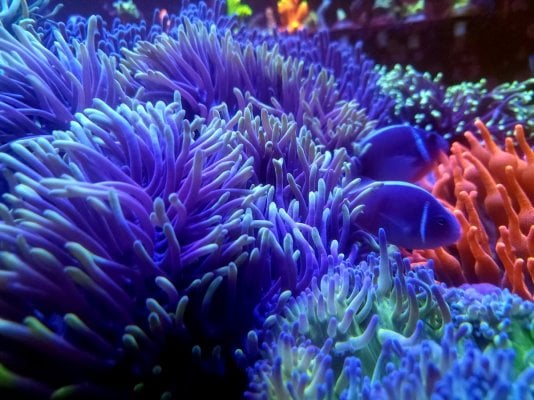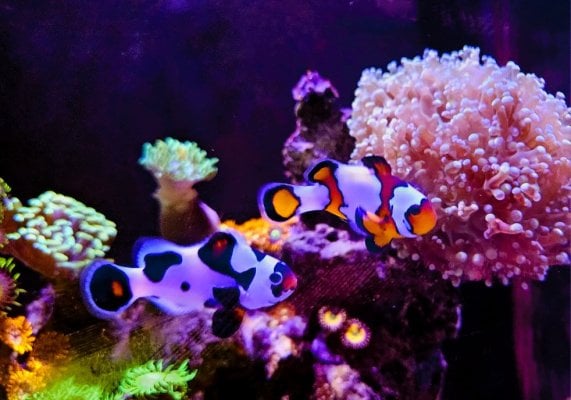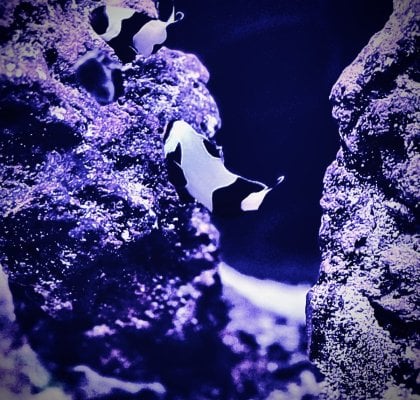Navigation
Install the app
How to install the app on iOS
Follow along with the video below to see how to install our site as a web app on your home screen.
Note: This feature may not be available in some browsers.
More options
You are using an out of date browser. It may not display this or other websites correctly.
You should upgrade or use an alternative browser.
You should upgrade or use an alternative browser.
Just clowning around! Do you have a favorite species of clownfish?
- QUESTION OF THE DAY
- Thread starter Peace River
- Start date
- Tagged users None
OrchidMiss
Official Reef Mermaid
View Badges

Partner Member 2024
NJRC Member
Hospitality Award
CRC Member
Reef Pumpkin Carver
EPRA Member
Rock Pool Reef Keepers
My Tank Thread
Felicia is a gold dot maroonI'm happy to nominate Luxo as the poster child of ocellaris clowns. I don't think there's a more famous ocellaris on this forum.
@OrchidMiss Felicia is a gold nugget? What kind is she? Definitely another one for the spotlight!
littlefoxx
7500 Club Member
View Badges
Excellence Award
Hospitality Award
Midwest Reefer
Rocky Mountain Reefers
Rock Pool Reef Keepers
R2R Secret Santa 2023
My Tank Thread
My Aquarium Showcase
She reminds me of Scarlet, my femaleFelicia is a gold dot maroon

Hard to pick just one. Out of all the bicinctus and brown saddlebacks are probably my favorites, but clarkii, orange skunks, pink skunks, perculas, ocellaris, and maroons are all nice as well.
I had walked into my LFS looking for a standard ocellaris but when I saw the frostbite I lost all control. It was probably the cutest thing I have ever seen! They look like they are wearing little masks 
So now I have two tiny clowns: an ocellaris and a frostbite!
I basically love them all.
So now I have two tiny clowns: an ocellaris and a frostbite!
I basically love them all.
I've always loved the bone stock ocellaris clowns. They were my first clowns.
I guess the gold strip maroons are a close second.
That first picture of the lightning maroons really was intriguing.
I guess the gold strip maroons are a close second.
That first picture of the lightning maroons really was intriguing.
I consider myself a purist, and perhaps a clownfish snob. My favorites are plain old Perculas without any fancy breeding. I also enjoy the Fire clowns. If they weren't so fierce I'd have tried to add two as a 2nd pair in my 180, but that's too much to risk.
I didn't vote because my favorites are the larger clowns, maroon, clarkii, tomato etc. I like to keep clownfish with nems and I have yet to have one of the larger species host a power head when there is a perfectly healthy nem in the tank  My currentl clarkii was in the hoddoni less than 15 minutes of being placed in the tank.
My currentl clarkii was in the hoddoni less than 15 minutes of being placed in the tank.
One of my dream pairs are to have a breeding pair of Pink Skunks.
Here are my 13 year old snowflakes

 www.reef2reef.com
www.reef2reef.com

Build Thread - Drukkosz upgrade - something little different
My 12 year old clownfish spawn every few weeks. Sometimes I am lucky enough to cut them in the act.
 www.reef2reef.com
www.reef2reef.com
One that doesn't bite me when I put my hand in it's tank.
My gold banded marron! As irritating as she can be when she decides to redecorate the tank. I have had her for 30 years and she has outlived every other fish, including her mate. She is the Queen of the tank and I think he got on her bad side. At this point she is family.
Well this is my first post so I hope I’m doing it correctly lol.. new to reefing have always wanted to have a saltwater tank .. an now I have become a sponge lol an try to soak up everything I can an I think i am doing ok at it so far I have me a bonded pair they crack me up there like little dogs that see you an come running across the tank to where ever I’m at my little puffer he’s the same way!!Just clowning around! Do you have a favorite species of clownfish?
A clownfish is a clownfish, right? While many people have an image of the seemingly ubiquitous clownfish, there are many variations. Not only are there different patterns of clownfish there are also many different species. In fact, right now there are about thirty different species of clownfish. Additionally, there are many patterns of clownfish such as some of my favorites: the bullet-hole Oscellaris and the lightning Maroon. Some of the species are more well know like the oscellaris, percula, maroon, clarkia, skunk, and tomato, however there are also lesser-known clownfish species that are available in the hobby such as the allardi, mcculochi, and omanensis. Do you have a favorite species of clownfish?

Photo by @Reef Pro; Amphiprion omanensis
This QOTD is sponsored by: www.tidalgardens.com

“The goal of Tidal Gardens is to offer the highest quality corals to those seeking a piece of that world without destroying it. We hope to instill a deep appreciation for the natural reefs and help develop a self-sustaining hobby that no longer requires the collection of fish and corals.”
Attachments
Gold band or the common maroon clown. I'm not a big fan of the "designer" strains. I'm more of a purist on some things.
Similar threads
-
- Poll
- Replies
- 48
- Views
- 1,283
- Replies
- 9
- Views
- 489
- Replies
- 25
- Views
- 728
-
- Poll
- Replies
- 73
- Views
- 3,308





















